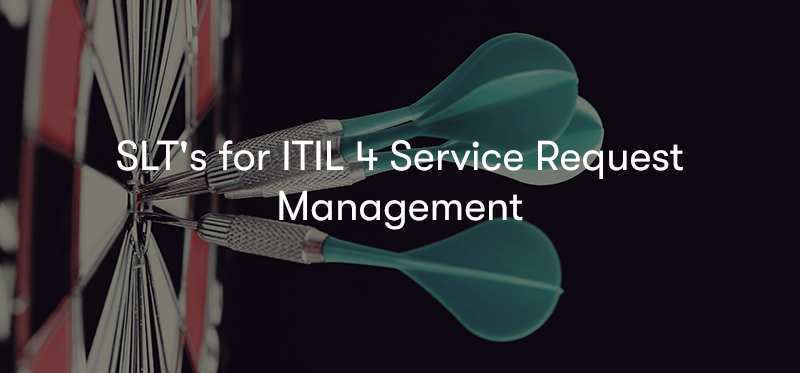ITIL 4 service request management is a crucial process within the ITIL framework, which aims to handle and fulfil service requests in an organised and efficient manner. It has evolved to address the changing needs of IT service management.
Service request management is one of ITIL4’s 34 practices. ITIL 4 defines this practice's purpose as:
“To support the agreed quality of a service by handling all predefined, user-initiated service requests in an effective and user-friendly manner.” - Axelos
Understanding ITIL Service Request Management
ITIL 4 introduces a more holistic and flexible approach to service management, including service request management. In ITIL 4, service request management is considered part of the broader practice of "Service Management," which encompasses both service delivery and service support.
ITIL 4 service request management focuses on understanding and fulfilling the needs and expectations of users or customers. It involves the following key components:
- Service Request Handling
- Self-Service
- Automation and Workflow
- Knowledge Management
- Continuous Improvement
We will be going into more detail with these key components later in this blog. Overall, ITIL 4 service request management focuses on delivering prompt, consistent, and user-centric services, leveraging automation, self-service options, and knowledge management to optimise the service delivery process.
If you would like to know more about service request management why not check out our ITIL 4 Service Request Management course
What is a Service Request in ITIL 4?
In ITIL 4, a service request refers to a formal or informal request from a user or customer for information, advice, or access to a particular service. It is a non-incident-related request that involves the provision of a predefined service with a specific outcome.
Service requests are typically routine, predefined, and repetitive in nature. They are often categorised into standard service offerings and are aimed at fulfilling specific user needs or enabling access to certain IT services. Examples of service requests include password resets, software installations, hardware requests, access permissions, account creations, and service configuration changes.
ITIL 4 emphasises the importance of efficiently managing service requests to provide a positive user experience and maintain productivity. The service request management process ensures that these requests are properly recorded, categorised, prioritised, and fulfilled. It may involve self-service options for users to submit requests independently, automation of workflows to streamline request handling, and knowledge management to capture and share solutions for common service requests.
By distinguishing service requests from incidents (which are unplanned interruptions to services), ITIL 4 allows organisations to allocate appropriate resources and prioritise actions based on the nature of the request, resulting in faster response times and improved service delivery.
What is ITIL Service Request Management?

ITIL 4 service request management is a comprehensive practice that focuses on efficiently managing and fulfilling service requests from users or customers. It involves several key components that work together to provide a smooth and user-centric experience. It encompasses the end-to-end process of managing service requests, from initiation to fulfilment, with the goal of meeting user needs and delivering value.
Service Request Handling
Service requests are logged and recorded in a centralised system. They are categorised based on predefined categories and characteristics such as request type, urgency, and impact. This classification helps in effectively managing and prioritising requests.
Self-Service Options
ITIL 4 promotes self-service capabilities, allowing users to independently submit and track their service requests. Self-service portals or knowledge bases provide users with information and tools to select the appropriate service request and provide necessary details. This empowers users and reduces dependency on IT staff for routine requests.
Automation and Workflow Management
Automation is leveraged to streamline and expedite service request fulfilment. Workflows are designed to automate tasks, assignments, approvals, and notifications. Automation helps in reducing manual effort, ensuring consistency, and accelerating response and resolution times.
Knowledge Management
Knowledge management plays a crucial role in ITIL 4 service request management. It involves capturing and sharing knowledge related to common service requests and their solutions. A centralised knowledge base enables support staff to access relevant information quickly, leading to faster and more accurate resolution of requests.
Continuous Improvement
ITIL 4 encourages organisations to adopt a culture of continuous improvement. Feedback from users, performance metrics, and key performance indicators are collected and analysed to identify areas for enhancement. Lessons learned from resolved requests are used to refine processes and improve service delivery.
By implementing ITIL 4 service request management, your organisation can streamline the handling of service requests, reduce response times, improve productivity, and enhance user satisfaction. The focus on self-service, automation, knowledge management, and continuous improvement enables efficient and customer-centric service request fulfilment.
What Are the Benefits of Service Request Management in ITIL 4?
Implementing ITIL 4 service request management brings several benefits to your organisation. Here are some key advantages:
Improved User Experience
ITIL 4 service request management focuses on providing a user-centric approach. By offering self-service options, users can independently submit and track their service requests, resulting in faster and more convenient access to requested services. This leads to increased user satisfaction and a positive overall experience.
Faster Request Fulfilment
ITIL 4 emphasises automation and streamlined workflows. By automating request handling processes, organisations can reduce manual effort, minimise errors, and accelerate response and resolution times. This allows for faster fulfilment of service requests, enhancing productivity and reducing user wait times.
Enhanced Efficiency and Productivity
With standardised processes and automation, ITIL 4 service request management improves efficiency and productivity. Tasks such as categorisation, assignment, and tracking of requests are automated, freeing up IT staff to focus on more complex and critical activities. This leads to optimised resource utilisation and increased productivity across the organisation.
Consistency and Compliance
ITIL 4 service request management promotes consistent handling of service requests based on predefined processes and workflows. This ensures compliance with established policies, procedures, and regulatory requirements. Standardisation reduces variability and ensures that requests are handled consistently, regardless of the individuals involved in the process.
Knowledge Sharing and Reuse
ITIL 4 emphasises knowledge management as a key component of service request management. By capturing and sharing solutions for common service requests in a centralised knowledge base, organisations can facilitate knowledge sharing and reuse. This reduces the need for repetitive troubleshooting and enables faster resolution of requests.
Continuous Improvement
ITIL 4 promotes a culture of continuous improvement. By regularly evaluating service request management processes, organisations can identify areas for enhancement and implement proactive measures to optimise service delivery. Continuous improvement helps to refine processes, increase efficiency, and enhance the overall effectiveness of service request management.
ITIL 4 service request management brings benefits such as improved user experience, faster request fulfilment, enhanced efficiency and productivity, consistency and compliance, knowledge sharing, and continuous improvement. It enables organisations to deliver services effectively and meet user expectations in a structured and customer-centric manner.
What is Service Request Fulfilment? (ITIL V3)
ITIL 4 Service Request Fulfilment is a specific practice within the ITIL V3 framework that focuses on efficiently and effectively fulfilling service requests from users or customers. It encompasses the activities and processes involved in delivering the requested services and meeting the defined service levels.
Key aspects of ITIL V3 Service Request Fulfilment include:
Request Logging and Categorisation
Service requests are logged in a centralised system, capturing all relevant details such as the nature of the request, requester information, and any additional information required for processing. Requests are then categorised based on predefined categories or types.
Request Fulfilment Process
Once a service request is logged and categorised, the appropriate workflow or process is initiated to fulfil the request. This includes task assignment, coordination with relevant teams or individuals, and tracking the progress of the request throughout its lifecycle.
Request Approval and Authorisation
Some service requests may require approval or authorisation before fulfilment. This step ensures that appropriate controls are in place and the request aligns with the organisation's policies, procedures, and security requirements.
Service Delivery and Fulfilment
The requested service is delivered to the user or customer based on the defined service levels and agreed-upon targets. This may involve activities such as provisioning resources, granting access permissions, installing software, configuring settings, or any other action necessary to fulfil the request.
Communication and Status Updates
Throughout the fulfilment process, regular communication with the requester is maintained. Updates on the progress, estimated completion time, and any potential delays or issues are provided to keep the requester informed and manage expectations.
Request Closure and Documentation
Once the service request is successfully fulfilled, it is closed in the system, and all relevant documentation and records are updated. This includes capturing any pertinent details, solutions applied, or changes made during the fulfilment process for future reference and knowledge management.
ITIL V3 Service Request Fulfilment aims to ensure that service requests are handled efficiently, with clear processes, effective communication, and timely delivery of requested services. By implementing well-defined practices and workflows, organisations can enhance customer satisfaction, improve productivity, and maintain service levels for non-incident-related requests.
What is the Service Request Management Process?
The ITIL 4 service request management process provides a structured approach to handle and fulfil service requests from users or customers. It involves a series of steps and activities designed to ensure that requests are properly logged, categorised, prioritised, and addressed. Here is an overview of the ITIL 4 service request management process:
Request Logging
The process begins with the logging of service requests in a centralised system or service desk tool. Requesters provide details about the nature of the request, any required information, and contact information.
Request Categorisation
Service requests are categorised based on predefined categories or types. This helps in organising and managing the requests effectively, enabling appropriate prioritisation and assignment.
Initial Assessment
Once a request is logged and categorised, it undergoes an initial assessment to determine its complexity, impact, and the appropriate resources needed for fulfilment. This assessment helps in prioritising requests based on urgency and importance.
Request Fulfilment
The actual fulfilment of the service request takes place in this stage. The necessary actions, tasks, or activities are performed to provide the requested service. This may involve provisioning resources, granting access, configuring settings, or any other actions as required by the request.
Request Communication
Throughout the process, effective communication with the requester is maintained. Updates on the progress, estimated completion time, and any potential delays or issues are provided to keep the requester informed.
Request Closure and Documentation
Once the service request is fulfilled, it is marked as closed in the system. Relevant documentation and records are updated to capture details about the request, the actions taken, and any changes made during the fulfilment process. This information is valuable for knowledge management and future reference.
Request Evaluation and Continuous Improvement
The service request management process is regularly evaluated to identify areas for improvement. Feedback from users and analysis of metrics and performance indicators help in refining the process and enhancing efficiency.
By following the ITIL 4 service request management process, organisations can ensure a consistent and structured approach to handle service requests, leading to improved customer satisfaction, faster response times, and effective delivery of requested services.
What Are the Priorities of Managing Service Requests?

In ITIL 4, managing service requests involves prioritising them based on their urgency and impact to ensure timely and efficient resolution. The priorities of ITIL 4 managing service requests are typically categorised into levels, such as:
Urgency
This refers to how quickly the service request needs to be addressed. It assesses the time sensitivity of the request and the impact of any delays. Urgency levels can be defined as high, medium, or low, depending on the criticality of the request.
Impact
Impact represents the significance or consequences of the service request on the organisation or users. It assesses the effect of the request on operations, productivity, or customer experience. Similar to urgency, impact levels can be categorised as high, medium, or low.
By combining the urgency and impact levels, ITIL 4 establishes a priority matrix or framework to guide the handling and prioritisation of service requests. This allows IT teams to allocate appropriate resources and prioritise actions accordingly. Here's an example of a priority matrix commonly used:
High Priority
Requests with high urgency and high impact are given the highest priority. These are critical requests that require immediate attention and have a significant impact on business operations or user experience.
Medium Priority
Requests with medium urgency and impact fall into this category. They are important but may not require immediate attention. These requests are typically addressed after high-priority requests are resolved.
Low Priority
Requests with low urgency and impact are considered low priority. They are non-critical and can be addressed after higher priority requests are resolved. These requests may have minimal impact on business operations or user experience.
By assigning appropriate priorities to service requests, IT teams can ensure efficient resource allocation, timely response and resolution, and effective utilisation of available resources. This helps in meeting service level targets (SLTs) and delivering services that align with business priorities.
SLT's for ITIL 4 Service Request Management

When defining Service Level Targets (SLTs) for ITIL 4 service request management, organisations typically establish measurable targets and expectations to ensure timely and satisfactory handling of service requests. While specific SLAs can vary depending on the organisation's needs and priorities, here are some common SLTs for ITIL 4 service request management:
Response Time
This SLT defines the maximum time within which the service desk or support team will acknowledge and respond to a service request. For example, a common SLT could be to respond to high-priority service requests within one hour, medium-priority requests within four hours, and low-priority requests within 24 hours.
Resolution Time
This SLT sets the target timeframe for fulfilling service requests. It specifies the maximum time allowed to complete the requested service. The resolution time can vary based on the complexity and nature of the request. For instance, it might be one business day for simple requests and three business days for more complex ones.
Escalation
This SLT outlines the escalation process when service requests cannot be resolved within defined timeframes or when the resolution exceeds certain thresholds. It specifies the steps to be taken and the individuals or teams to escalate the request to, ensuring that unresolved requests receive appropriate attention and priority.
Availability
This SLT pertains to the availability of self-service portals or channels for submitting service requests. It ensures that users have access to the service request platform during specified hours or round the clock, enabling them to submit requests at their convenience.
Self-Service Success Rate
This SLT measures the success rate of self-service options for service requests. It sets a target percentage of service requests that should be successfully submitted, tracked, and resolved through self-service channels without the need for manual intervention.
Customer Satisfaction
This SLT focuses on measuring and improving customer satisfaction with the service request management process. It may involve surveys or feedback mechanisms to collect user satisfaction ratings and comments, with a target satisfaction score to be achieved.
These are some examples of common SLTs for ITIL 4 service request management. However, organisations should tailor their SLTs to align with their specific business objectives, customer expectations, and available resources to ensure that the SLTs are both achievable and meaningful.
What Are the Best Practices for Managing Service Requests?

When it comes to managing service requests, there are several best practices that organisations can follow to ensure efficient and effective handling. Here are some key best practices for managing service requests:
Implement Self-Service Options
Provide user-friendly self-service portals or knowledge bases that allow users to independently submit and track their service requests. Self-service options empower users, reduce wait times, and increase satisfaction by providing faster access to requested services.
Standardise and Automate Workflows
Establish standardised processes and workflows for handling service requests. Automation tools can be employed to streamline request processing, assign tasks, track progress, and generate notifications. Standardisation and automation help maintain consistency, improve efficiency, and reduce manual errors.
Prioritise and Categorise Requests
Classify and prioritise service requests based on predefined categories, urgency, and impact. This allows for appropriate assignment and resource allocation. Use a priority matrix to guide the handling and resolution of requests, ensuring critical requests receive prompt attention.
Set Clear Service Level Targets (SLTs)
Define measurable SLTs that specify response times, resolution times, escalation procedures, and availability of self-service options. SLTs help set expectations, prioritise work, and ensure timely resolution of service requests.
Foster Effective Communication
Maintain regular and transparent communication with requesters throughout the request lifecycle. Keep users informed about the progress, estimated completion times, and any potential delays or issues. Effective communication helps manage expectations and enhances customer satisfaction.
Establish Knowledge Management Practices
Implement a centralised knowledge base to capture solutions for common service requests. Encourage knowledge sharing among support staff and promote the reuse of solutions. This helps in resolving requests faster, reducing the need for repetitive troubleshooting, and improving overall efficiency.
Continuously Evaluate and Improve
Regularly assess the service request management process, collect user feedback, and analyse performance metrics. Identify areas for improvement and implement proactive measures to enhance the process, increase efficiency, and improve customer satisfaction.
Provide Training and Documentation
Ensure that support staff are well-trained on service request management processes, tools, and best practices. Develop and maintain documentation and training materials to guide staff and foster consistency in handling service requests.
By following these best practices, organisations can optimise their service request management process, enhance customer satisfaction, improve productivity, and deliver timely and effective services to their users or customers.
The Difference Between Service Request Management and Incident Management

Service Request Management and Incident Management are two distinct processes within IT service management. While both processes deal with user requests and aim to provide effective support, they differ in their scope and nature. Here are the key differences between Service Request Management and Incident Management:
Scope and Purpose
Service Request Management: It focuses on fulfilling user requests for standard services, information, or access that are pre-defined and well-documented. Service requests are generally non-urgent and do not involve an interruption or degradation of service.
Incident Management: It focuses on resolving and restoring services that have been disrupted or degraded due to incidents. Incidents refer to any unplanned interruptions or reductions in service quality that cause a disruption to normal operations.
Nature of Requests
Service Request Management: Requests in this process are typically routine, repetitive, and predictable. Examples include password resets, software installations, hardware provisioning, or access permissions. Service requests follow predefined and documented procedures.
Incident Management: Incidents involve unexpected and unplanned events that impact the availability or performance of services. They require a rapid response to diagnose, resolve, and restore services to their normal state. Incidents can vary in severity and complexity.
Handling Approach
Service Request Management: The focus is on efficient fulfilment of requests through standardised processes and automation. Self-service options may be provided to enable users to submit and track their requests independently.
Incident Management: The emphasis is on timely response and resolution of incidents to minimise service downtime. Incident management follows a structured approach, including incident identification, logging, categorisation, prioritisation, investigation, diagnosis, resolution, and closure.
Impact on Business
Service Request Management: Service requests have a minimal impact on business operations and usually involve fulfilling user requirements efficiently. They do not generally cause significant disruption to service availability.
Incident Management: Incidents can have a substantial impact on business operations, productivity, and user experience. The focus is on minimising the impact of incidents and restoring services as quickly as possible to ensure continuity.
In summary, Service Request Management handles routine, predefined, and non-urgent user requests for standard services or information, while Incident Management focuses on the rapid resolution of service disruptions or degradations. The key distinction lies in the nature, urgency, impact, and handling approach for these different types of user interactions.
Where Can You Learn More?
ITIL 4 launched a course called ITIL® 4 Practitioner: Service Request Management which is based off the Service Request Management practice. This one day course can bring significant benefits to your organisation. By implementing efficient service request processes, your organisation can streamline your operations, enhance customer satisfaction, and improve overall productivity. ITIL service request management focuses on handling various user requests, such as password resets, software installations, or equipment procurement.
Please note ITIL® 4 Foundation is a prerequisite for this course.
Five New Practises for ITIL 4
There are 34 ITIL® management practices in total, representing some of the most practical resources of the framework. 5 have been released so far as courses under the title of ITIL practitioner, these are:

ITIL® 4 Practitioner: Service Desk
The ITIL Service Desk practice focuses on providing efficient and effective support to users. It involves establishing a single point of contact to handle incidents, service requests, and general inquiries, ensuring timely resolution and maintaining customer satisfaction through proper communication and problem-solving techniques.

ITIL® 4 Practitioner: Incident Management
The ITIL Incident Management practice aims to minimise the impact of incidents on business operations. It involves the identification, logging, categorisation, prioritisation, and resolution of incidents, ensuring a swift restoration of services and minimising disruption to users while adhering to predefined SLAs.

ITIL® 4 Practitioner: Problem Management
The ITIL Problem Management focuses on identifying and eliminating the root causes of recurring incidents. It involves both reactive and proactive analysis, investigation, and resolution of problems to prevent future incidents, improving overall service quality and minimising business disruption. It aims to implement long-term solutions and maintain service stability.

ITIL® 4 Practitioner: Service Request Management
The ITIL Service Request Management practice facilitates the efficient handling and fulfilment of user requests. By establishing a streamlined process for capturing, categorising, prioritising, and fulfilling service requests. It aims to enhance customer satisfaction by providing a convenient and responsive experience for users' non-incident-related needs.

ITIL® 4 Practitioner: Monitoring & Event Management
The ITIL Monitoring & Event Management practice focuses on monitoring IT infrastructure and applications to detect and respond to events that may impact service performance. It involves real-time monitoring, event correlation, and automated notifications, enabling timely response and resolution of issues, minimising downtime, and optimising service availability and performance.
The individual practices are each offered through separate one-day training courses or bundled into a three-day training course called ITIL® 4 Specialist: Monitor, Support & Fulfil.
Final Notes On ITIL Service Request Management
Service request management provides a structured and streamlined process for handling service requests, ensuring consistency and efficiency. It enables organisations to capture and prioritise service requests, reducing the risk of requests being missed or delayed. By automating and standardising service request workflows, ITIL helps in improving response times and customer satisfaction. It also facilitates better communication and coordination among various teams involved in fulfilling requests. Furthermore, ITIL service request management enables organisations to track and measure their service request performance, identify areas for improvement, and optimise resource allocation. Ultimately, it helps organisations enhance their overall service delivery and achieve higher levels of operational excellence.
For more information on service request management, why not check out our ITIL® 4 Practitioner: Service Request Management course.




